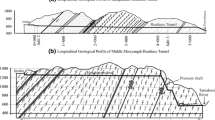Abstract
Most of the analytical approaches that are available for assessing plastic deformation in tunnels that pass through weak, schistose, and foliated rock masses assume an isostatic stress state. However, in situ stresses are seldom isostatic in a tunnel passing through a varying rock overburden. The work reported here analyzed the effect of stress anisotropy on the magnitude of plastic deformation in the Kaligandaki headrace tunnel in the Nepal Himalaya, where extensive deformation monitoring plans were implemented during tunnel excavation. Recorded tunnel deformation, mapped geological information, lab-tested rock mechanical properties, and an approach reported by Hoek and Marinos (Tunn Tunn Int 32(11):45–51, 2000) were used to estimate rock mass parameters. The convergence confinement method (Carranza-Torres and Fairhurst, Tunn Undergr Space Technol 15(2):187–213, 2000) was used to assess the effective support pressure for the known tunnel deformations of 77 tunnel sections assuming an isostatic stress state. Numerical modeling was carried out to assess the effect of stress anisotropy on tunnel deformation. The analysis indicated that CCM overestimates the magnitude of tunnel deformation. This may be explained by the fact that CCM applies for a circular tunnel in the isostatic stress state, which is seldom the case. Actual measured deformations were calibrated using numerical modeling to develop equations that may be used to estimate the plastic deformation of tunnels that are subjected to stress anisotropy. However, it should be emphasized that the proposed equations are based on the data records for a single tunnel, so further validation will be needed using data records of other well-monitored tunnel projects.














Similar content being viewed by others
References
Carranza-Torres C (2004) Elasto-plastic solution of tunnel problems using the generalized form of the Hoek–Brown failure criterion. Int J Rock Mech Min Sci 41(3):480–481
Carranza-Torres C, Fairhurst C (2000) Application of the convergence–confinement method of tunnel design to rock masses that satisfy the Hoek–Brown failure criterion. Tunn Undergr Space Technol 15(2):187–213
Crowder JJ, Bawden WF (2004) Review of post-peak parameters and behavior of rock masses: current trends and research. Rocnews, fall. http://www.rockscience.com
Detournay E, John CMS (1988) Design charts for a deep circular tunnel under non-uniform loading. Rock Mech Rock Eng 21:119–137
Goel RK, Jethwa JL, Paithankar AG (1995) Indian experience with Q and RMR systems. Tunn Undergr Space Technol 10:97–109
Hoek E, Diederichs MS (2006) Empirical estimation of rock mass modulus. Int J Rock Mech Min Sci 43:203–215
Hoek E, Marinos P (2000) Predicting tunnel squeezing problems in weak and heterogeneous rock masses. Tunn Tunn Int 32(11):45–51 [32(11): 34–46]
Hoek E, Carranza-Torres C, Corkum B (2002) Hoek–Brown failure criterion—2002 edition. In: Proc N Am Rock Mech Soc Meet, 8–10 July 2002, Toronto, Canada
Itasca (2009) FLAC3D user’s manual. http://www.itascacg.com
Nepal KM (1999) A review of in situ testing of rock mechanical parameters in hydropower projects of Nepal. J Nepal Geol Soc 19:1–8
Nepal Electricity Authority (NEA) (2002) Kaligandaki A hydroelectric project—project completion report: vols I-C (headrace tunnel); IV-A (geology and geotechnical); V-C (geological drawings and exhibits). Kathmandu, Nepal
Pan Y, Chen Y (1990) Plastic zones and characteristic-line families for openings in elasto-plastic rock mass. Rock Mech Rock Eng 23:275–292
Panet M (1995) Le calcul des tunnels par la méthode convergence-confinement. Presses de I’ENPC, Paris
Panet M (2001) Recommendations on the convergence confinement method. Association Française des Travaux en Souterrain (AFTES), Paris, pp 1–11
Panthi KK (2006) Analysis of engineering geological uncertainties analysis related to tunnelling in Himalayan rock mass conditions. Doctoral thesis. Department of Geology and Mineral Resources Engineering, Norwegian University of Science and Technology, Trondheim
Panthi KK (2012) Evaluation of rock bursting phenomena in a tunnel in the Himalayas. Bull Eng Geol Environ 71:761–769. doi:10.1007/s10064-012-0444-5
Panthi KK, Nilsen B (2007) Uncertainty analysis of tunnel squeezing for two tunnel cases from Nepal Himalaya. Int J Rock Mech Min Sci 44:67–76
Singh B, Jethwa JL, Dube AK, Singh B (1992) Correlation between observed support pressure and rock mass quality. Tunn Undergr Space Technol 7(1):59–74
Vlachopoulos N, Diederichs MS (2009) Improved longitudinal displacement profiles for convergence confinement analysis of deep tunnels. Rock Mech Rock Eng 42:131–146
Author information
Authors and Affiliations
Corresponding author
Rights and permissions
About this article
Cite this article
Shrestha, P.K., Panthi, K.K. Assessment of the effect of stress anisotropy on tunnel deformation in the Kaligandaki project in the Nepal Himalaya. Bull Eng Geol Environ 74, 815–826 (2015). https://doi.org/10.1007/s10064-014-0641-5
Received:
Accepted:
Published:
Issue Date:
DOI: https://doi.org/10.1007/s10064-014-0641-5




